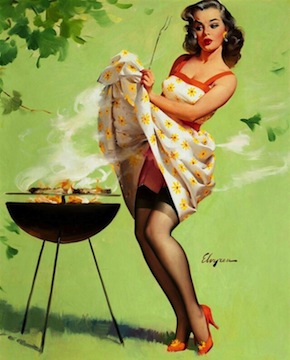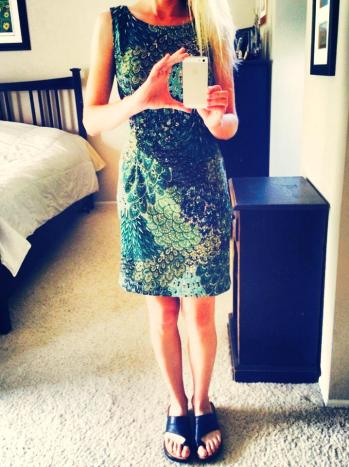Did you know that privileged men were the first to wear high heels? Way back in the 17th century, heels provided a beneficial lift while riding horses. Gradually, privileged women followed suit, both genders wearing them to convey prestige and power.
This all changed in the next century, when men and women’s dress began to reflect social class and profession.
And here’s the clincher, IMO:
Because men were considered the more intellectual and capable sex, they gave up heels for practical shoes they could do work that smart and powerful folks do (such as business and politics). Women’s perceived inadequacies made walking well less important. To ensure that they stayed as lovely to look at as possible—their main skill set other than childbirth—high heels became more decorative.
Men’s shoes became comfortable, reliable and supportive, while women’s remained decorative, unstable and painful. Because who cares if decorations can walk well or get hurt?
I wish I were kidding. (Learn more here, here, here and here.)
While women have more opportunities, choices and respect nowadays, it’s still complicated…
Stilettos, the most hazardous heels, appeared in the 1950s, when the fashion industry made the wartime pinup-girl look a trend. Women did everything from housecleaning to posing for erotic photos in the steep shoes. Meanwhile, they were seldom allowed positions of power or leadership.
The heels trend diminished a bunch during the 60s and 70s (I LOVE YOU, HIPPIES!), but not for long.
In the 1980s, as women began readily climbing the corporate ladder, people feared that such work would strip away their desirability—by, you know, doing all that “man stuff.” Particularly tall stilettos were marketed as a solution, a way to stay sexually appealing while moving forward professionally.
By 2000, high heels were called a woman’s “power tools.” Her sex appeal was popularly considered her main source of professional strength, one she could use to manipulate people, giving “working your way to the top” a whole new meaning.
High heels are still associated with prestige and sexiness, regardless of well-known risks they raise for pain, bunions, fractures, bone deterioration and more. Related injuries have nearly doubled in the last decade, which speaks of their popularity and women’s determination to wear and embrace them, but more so of the media and fashion industry’s power of persuasion. (If comfortable, supportive shoes were all the rage, we’d be wearing them by the masses.)
Does any of this make wearing high heels wrong? Or anti-feminist?
Of course not. Feminism is about equality. We should all have the freedom to dress and express ourselves as we choose.
If you feel empowered by high heels and love wearing them, go for it. (If you do, consider these doctor recommended tips.) No one should be shamed for wearing any particular type of apparel.
I think it’s important, however, to put thought into what we find strengthening and why. The more informed we are, the better choices we can make for ourselves. And the better choices we make for ourselves, the better role models we become for others.
I also feel there’s a fine line between putting a bandaid on insecurity and empowerment. A few months ago, I probably would’ve told you I wore heels at important events because they helped me feel empowered—more capable, attractive and confident. Now I realize they gave me a false sense of security and worked against me in numerous ways, from foot pain and poor body control to a lack of authenticity.
Why did I feel the need to stand taller? To have my calf muscles clenched? To make my legs look any different than they naturally are? (I explored these questions in my first #HeelFree post, available here.) Why do any of us?
In short, because of societal messages. We’re taught that high heels are a near prerequisite to sexiness, confidence and success. They’re considered a way up in the world, literally and figuratively, as they have been since their invention.
But times have changed. We don’t need to rely on our society’s idea of “sexiness” in order to have the careers, respect and lives we desire. I plan to live as long and as happily as possible, and I just don’t think that footwear that causes irreparable damage and makes walking comfortably difficult facilitates that—at least not for me.
I’ve also noticed in my years of work with folks with eating disorders and related issues that poor body image often goes hand-in-hand with high-heel wearing; it’s another common means of changing our outsides to aid inner wounds. But again, that’s a bandaid, not a solution.
If you can relate, I hope you’ll prioritize greater self-love and acceptance—regardless of your shoe choices. If there are any “power tools” worth having, it’s these.
If we wish to change the harsh pressures placed on women to appear a certain shape, size and height, we have to start with ourselves—by not holding ourselves up to those standards and by valuing what matters most. Whether you’re joining me in going #HeelFree or not, I hope you’ll consider taking whatever positive steps you can.
If you’re obsessive passionate like me, you’ll blab about it in the process. 😉 If not, you can still help better the world.
As a reminder, I’m posting #HeelFree photos and links on Facebook, Twitter and Instagram. Feel free to join the conversation!
What surprised you about high heels’ history? If you wear them regularly, how do they make you feel? Have you embraced your legs and height as they are? I’d love to hear your thoughts! ♥







